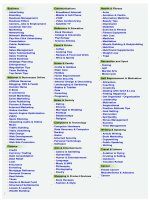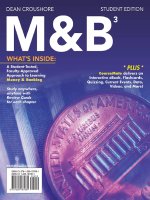Money and Banking: Lecture 35
Bạn đang xem bản rút gọn của tài liệu. Xem và tải ngay bản đầy đủ của tài liệu tại đây (354.03 KB, 20 trang )
Money and
Banking
Lecture 35
Review of the Previous Lecture
•
•
•
•
Deposit Creation in a Single Bank
Deposit Creation in a System of Banks
Deposit Expansion Multiplier
Deposit Expansion with Excess Reserves
and Cash Withdrawals
• Money Multiplier
Money Multiplier
•
Remember, we discussed that
•
•
Assuming
• no excess reserves are held
• there are no changes in the amount of currency
held by the public,
the change in deposits will be the inverse of the
required deposit reserve ratio (rD) times the change
in required reserves, or
∆D = (1/rD) ∆RR
• Alternatively
• RR = rDD
or ΔRR = rDΔD
• So for every dollar increase in reserves,
deposits increase by
1
rD
• The term (1/rD) represents the simple deposit
expansion multiplier.
• A decrease in reserves will generate a deposit
contraction in a multiple amount too
Money Multiplier
• The money multiplier shows how the quantity
of money (checking account plus currency) is
related to the monetary base (reserves in the
banking system plus currency held by the
nonbank public)
• Taking m for money multiplier and MB for
monetary base, the Quantity of Money, M is
M = m x MB
(This is why the MB is called High Powered Money)
• Consider the following relationships
Money = Currency + Checkable deposits
M=C+D
Monetary Base = Currency + Reserves
MB = C +R
Reserves = Req. Res. + Exc. Res
R = RR + ER
• The amount of excess reserves a bank holds
depends on the costs and benefits of holding
them,
• the cost is the interest foregone
• the benefit is the safety from having the reserves in
case there is an increase in withdrawals
• The higher the interest rate, the lower banks’
excess reserves will be; the greater the
concern over possible deposit withdrawals, the
higher the excess reserves will be
Introducing Excess Reserve Ratio {ER/D}
• R = RR + ER
= rDD + {ER/D}D
= (rD + {ER/D})D
•
•
The decision of how much currency to
hold depends on the costs and benefits,
where the cost is the interest foregone
and the benefit is the lower risk and
greater liquidity of currency.
As interest rates rise cash becomes less
desirable, but if the riskiness of
alternative holdings rises or liquidity falls,
then it becomes more desirable
Now taking Currency Ratio as {C/D}
• MB = C + R
= {C/D}D + (rD + {ER/D})D
= ({C/D} + rD + {ER/D})D
• This shows that Monetary base has three uses
• Required reserves
• Excessive reserves
• Cash in the hands of nonbank public
Deposit Expansion with Excess Reserves and Cash Withdraws .
D
M
1
{C/D} rD
{ER/D}
x MB
{C / D} 1
x MB
{C/D} rD {ER/D}
The Quantity of Money (M) Depends on:
• The Monetary base (MB), Controlled by the
central bank.
• Reserve Requirements
• Bank’s desired to hold excess reserves.
• The public’s demand for currency.
•
•
The quantity of money changes directly with
the base, and for a given amount of the base,
an increase in either the reserve requirement
or the holdings of excess reserves will
decrease the quantity of money.
But currency holdings affect both the
numerator and the denominator of the
multiplier, so the effect is not immediately
obvious. Logic tells us that an increase in
currency decreases reserves and so
decreases the money supply
The Central Bank’s Monetary
Policy Toolbox
• Central bank controls the quantity of
reserves that commercial banks hold
• Besides the quantity of reserves, the
central bank can control either the size of
the monetary base or the price of its
components
•
The two prices it concentrates on are
•
•
•
interest rate at which banks borrow and lend
reserves overnight (the federal funds rate)
interest rate at which banks can borrow
reserves from the central bank (the discount
rate).
The central bank has three monetary
policy tools, or instruments:
•
•
•
the target federal funds rate,
the discount rate, and
the reserve requirement.
The Target Federal Funds Rate
and Open Market Operations
•
•
•
The target federal funds rate is the
central bank’s primary policy instrument.
The federal funds rate is determined in
the market, rather than being controlled
by the central bank.
The name “federal funds” comes from
the fact that the funds banks trade their
deposit balances at the federal reserves
or central bank.
•
•
Central bank holds the capacity to force
the market federal funds rate to equal
the target rate all the time by
participating directly in the market for
overnight reserves, both as a borrower
and as a lender.
As a lender, the central bank would need
to make unsecured loans to commercial
banks, and as a borrower, the central
bank would in effect be paying interest
on excess reserves
• The central bank chooses to control the
federal funds rate by manipulating the
quantity of reserves through open market
operations: the central bank buys or sells
securities to add or drain reserves as
required.
Chapter 18
End of Chapter









